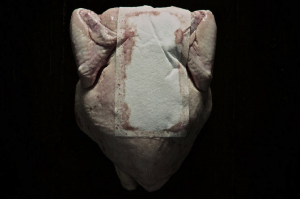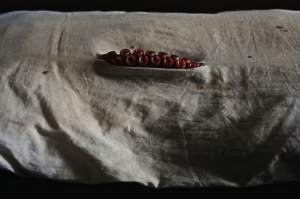Isobel Philip comes face to face with the uncanny strangeness of Eden Diebel’s photography…
The photographs that make up Eden Diebel’s show Against Nature at galleryeight hover – or rather dance – on the edge of a very fine divide. Simultaneously beautiful and grotesque, they unnerve the viewer. They are disquieting, yes, but they are also incredibly seductive.
Diebel’s subjects, raw meat, seafood and the odd onion, transcend their materiality. Carefully arranged, prodded with pins and torn open these foodstuffs are unrecognizable. Their forms are almost human (specifically those charged with implicit and metaphoric references to genitalia), but not quite. They are something quite ‘else’.
Photographic print, 91x61cms.
The photographs of chicken, notably Priest and Puncture, are most palpably human. These bodies have a texture and pallid complexion (with tinges of pink blood) that recalls the texture of human flesh. It took me a while – a second glance – to register that both were in fact chickens. Priest is particularly perturbing. This ‘figure’ is painfully fragile with its wings delicately tucked into its swollen torso. The paper towel lying across its chest is dense with collected blood.
Diebel’s photographs do not simply work on a visual register, but seem to operate through a kind of non-corporeal tactility. By this I mean that the images induce the sensation of touch without contact – as if one can feel the forms without holding them.
Experiencing the works then becomes a haptic exercise. You feel the pricks of those pins and the bulging of that flesh as your eyes move from work to work. The subtlety of the violence ingrained in each image is transferred to the viewer; not only is the flesh of the fish and chickens distorted and punctured, but ours is too.
The way the forms are lit, against a vacuous black background, heightens their intensity. They seem to construct a similar aesthetic to 16th Century Spanish still lives whose subjects (including animal carcasses and raw fish) surface momentarily from the void of a deep and immersive darkness.
Photographic print, 91x61cms.
Diebel cultivates a stylized grotesqueness that is metaphoric, rather than literal. This is not the grotesqueness of an abattoir. It is more complex than that. It is a subtle grotesqueness, revealed through a delicacy of form, as it is in Man ‘O’ War, where a blood red octopus tentacle protrudes from a cheesecloth like an open wound.
Looking at these works, the connotations that haunt the notion of the grotesque, binding it to the hideous and the ugly, start to slip away. These images possess a powerful beauty – they are not ugly. They catch your gaze and hold it captive, pulling you into their darkness.



Pingback: Tweets that mention The Pull of the Grotesque | The Art Life -- Topsy.com
Isobel Philip Review 31 Aug 2010
Having just read Isobel’s evocative review of Eden Diebel’s photography exhibition – the review as confronting and raw as its subject matter, I was asked to suspend my reactions, as when I viewed Ron Mueck’s Still Life (2009), visceral revulsion as I cringed at the ‘grotesque’, ‘hideous’ and ‘ugly’. These photographs seem to inhabit that other level of art, which Susanna Greeves in that exhibition’s catalogue noted as nature morte, natura morta – while still life of flowers and fruit do not overwhelm me – these images and even Isobel’s review has the power to do so. I wondered why?
It occurred to me that recent psychological understanding of trauma may offer me clue. For good reason it is that as I read Isobel’s review, images from long-ago, repressed visions and touch of dead flesh, from my days as a medical student in the anatomy dissection room, surfaced from my void.
Looking back to those moments, engraved as only trauma can engrave lasting experiences, yet, which we did not realize as teenagers as traumatic at that time, now resonates for me, with an awareness of our fragile mortality as humans.
From Isobel’s review, as I personalize her review’s conclusion, ‘caught my gaze and held me captive, pulling me into my darkness’, to those weeks and months as a medical student, on the very fine divide between being unnerved, and now, at once transcending that mere materiality of mortality. Decades later, what an unexpected and comforting follow-up to my incomplete medical education. Thank you, Isobel.
EMBRACIN TEH GROTESQUE TRANZFORMS IT